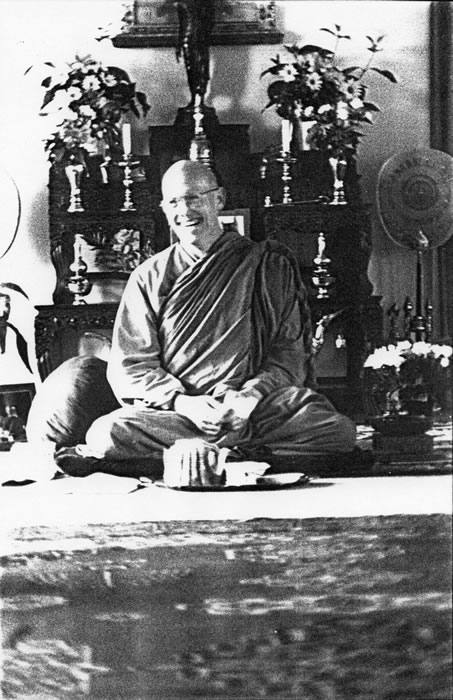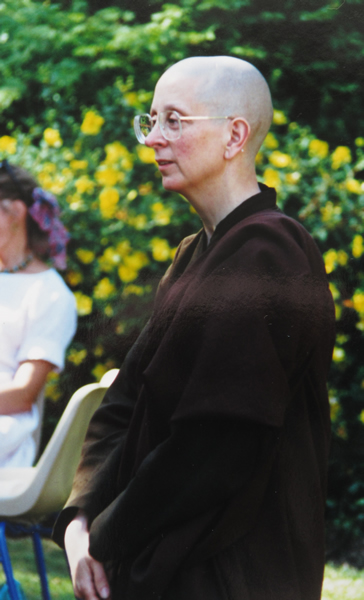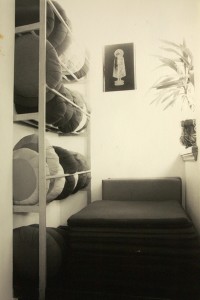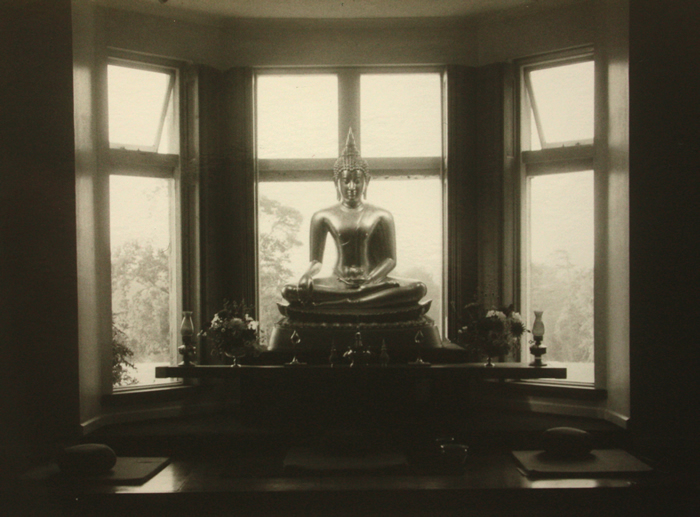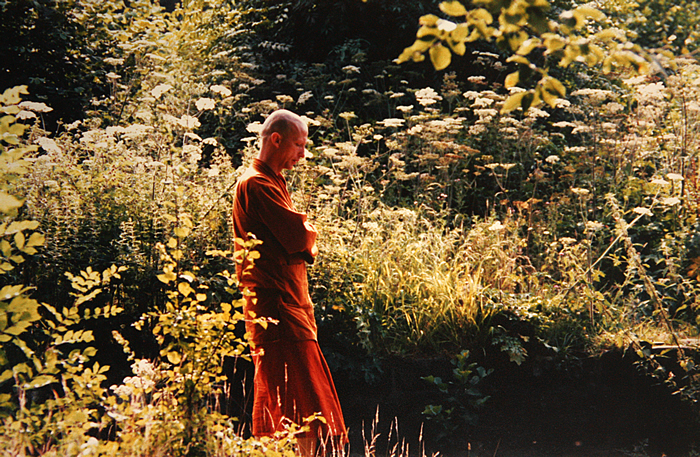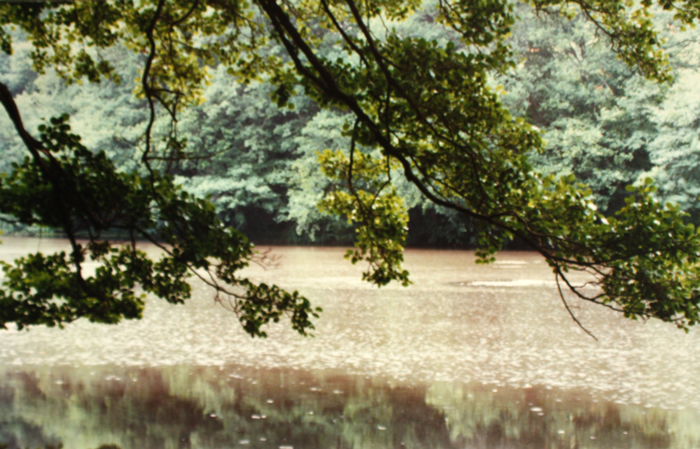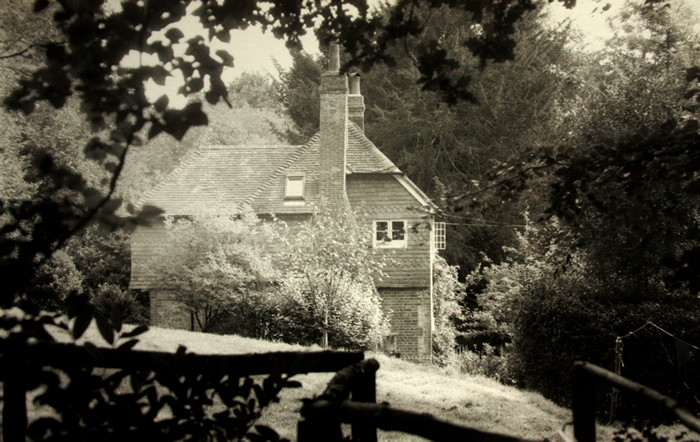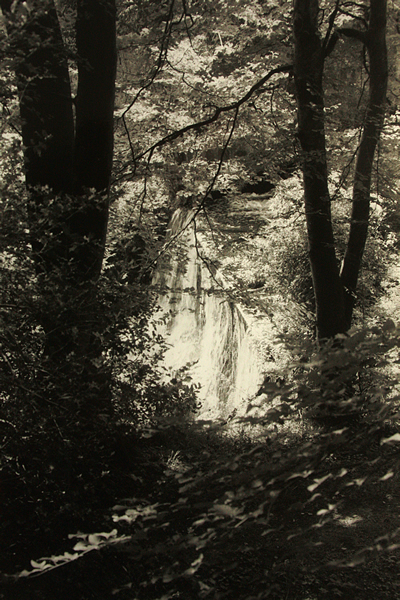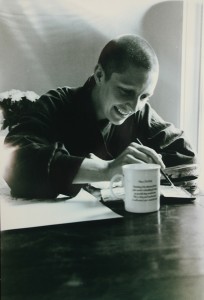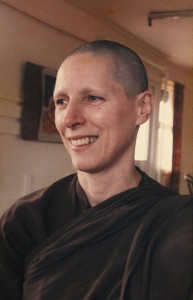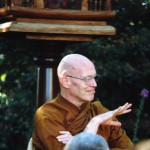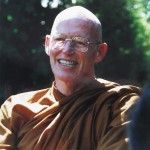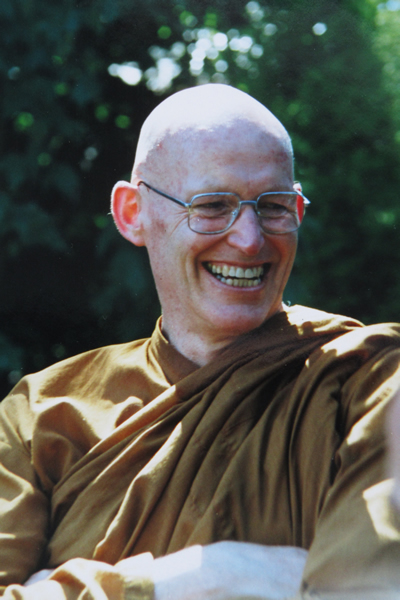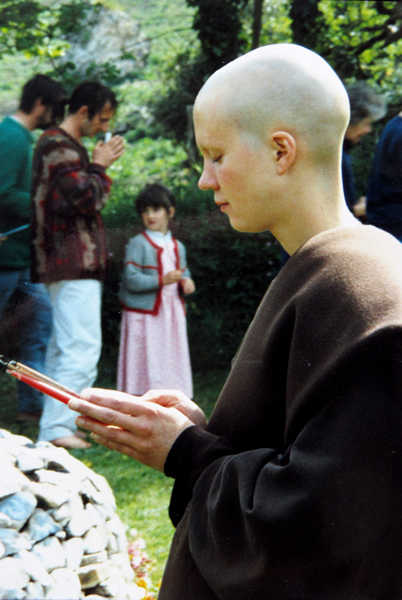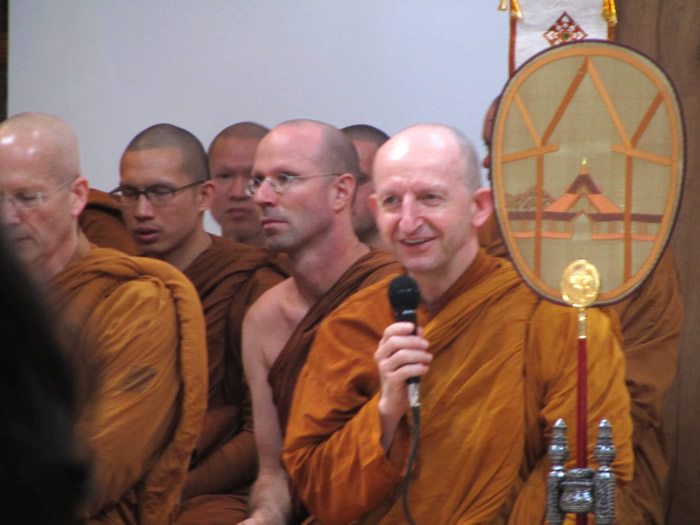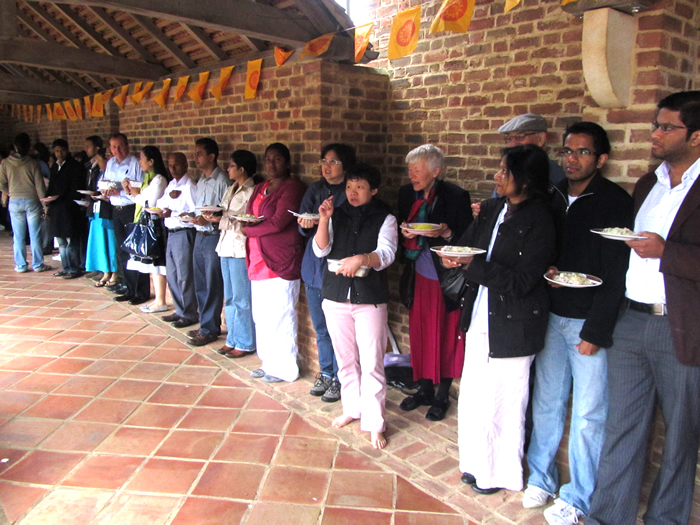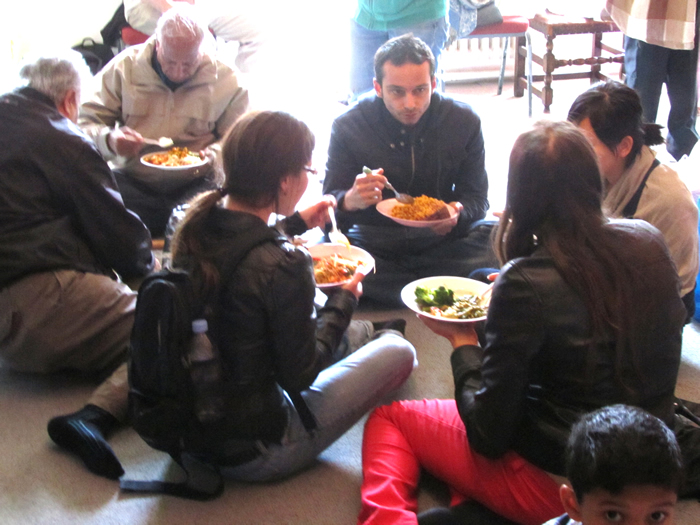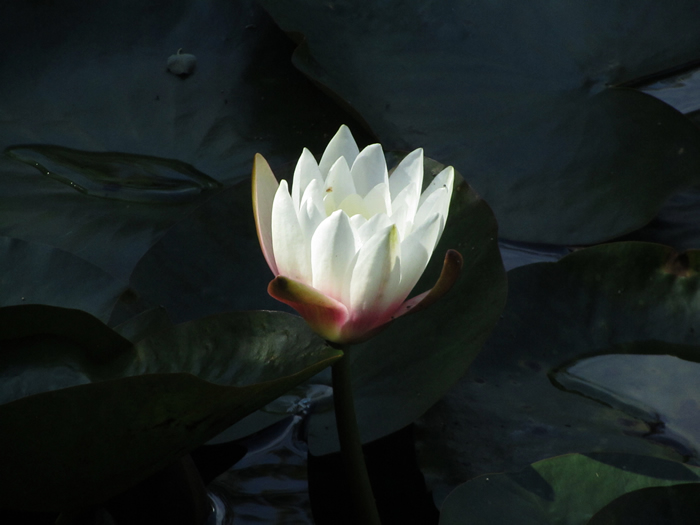A collection of images reflecting Buddhist practice in England. The tradition shown here is “the Way of the Elders” Theravada and it shows bhikkhus, (monks), siladhara, (nuns), and lay supporters of the Community (the Sangha), Thai, Sri Lankan and Western. The pictures were taken by me at Amaravati outside Hemel Hempstead, at Chithurst Monastery near Petersfield and at the Devon Vihara near Honiton at Harnham. The first group of images were taken around 2009 as digital images. There then follows a collection copied from my prints of photos taken around 1985 when I first came in contact with the Theravda monks and nuns of the Forest Monastery tradition. I mislaid these photos for many years and have recently found them and have offered copies to the Sangha. If you would like to look at a basic introduction to Buddhist teaching and practice see my article at: 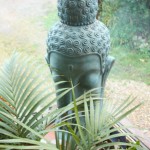
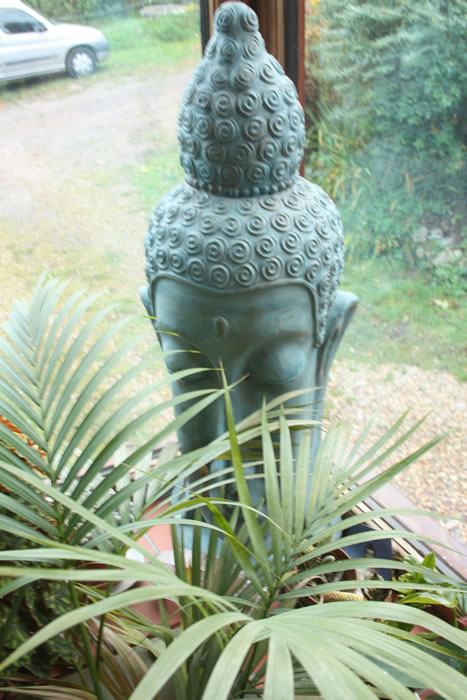
An image of the Buddha cast in bronze from Thailand. A gift to the Devon Vihara. Here a small community of monastics have practiced and explored the Buddha's teaching along with lay Buddist supporters since 1986.
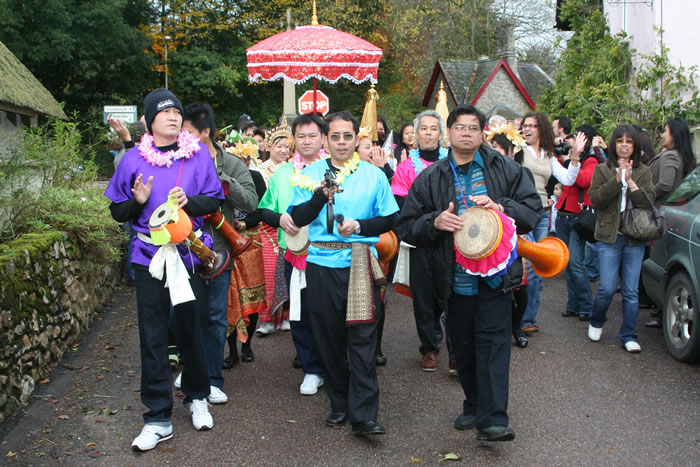
Thai supporters of the Devon Vihara (monastery or temple) make a point of coming in coachloads for the annual Kathina Festival. In this they offer the cloth for a monastic robe which the monks then spend the night sewing according to the pattern passed down from the Buddha. This is a joyous and enthusiastic ceremony emphasising the respect felt by lay supporters for those who take on the demands of the Buddha's full system of training. The noise of cymbals, drums and trumpets comes as a bit of a shock to the quiet village of Harnham outside Honiton. 2009.
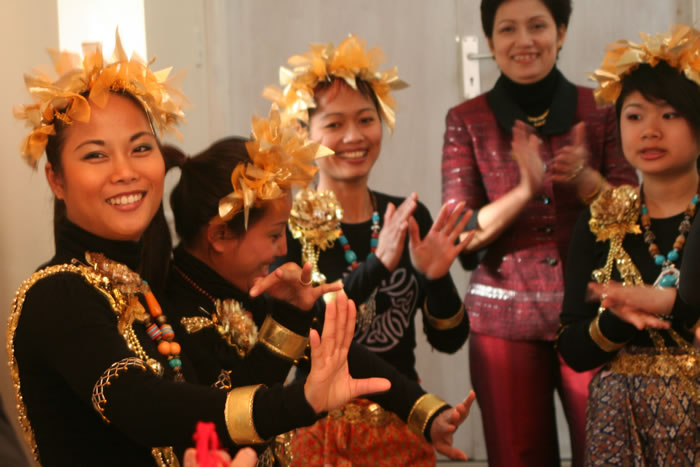
A group of Thai ladies, some with rather bemused English husbands, dress in festival finery for the occasion.
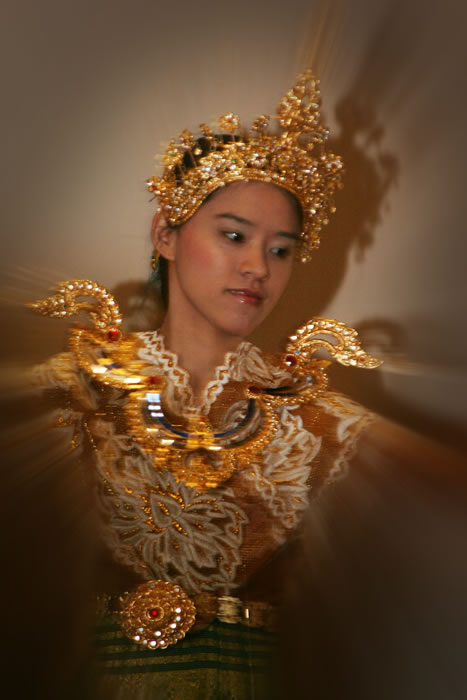
Two young women had carefully practiced a traditional dance in honour of the Buddha which the monks could not watch for they give up such entertainment.
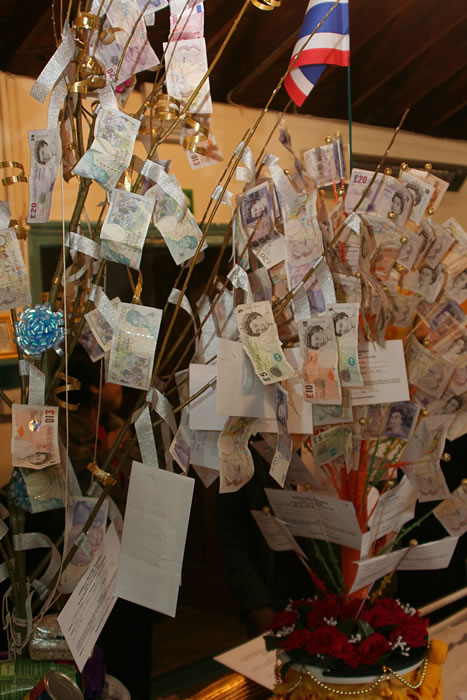
Also in the parish hall (the crowd being too big for the Vihara) was a traditional "money tree" where lay supporters place notes for the support of the Community.
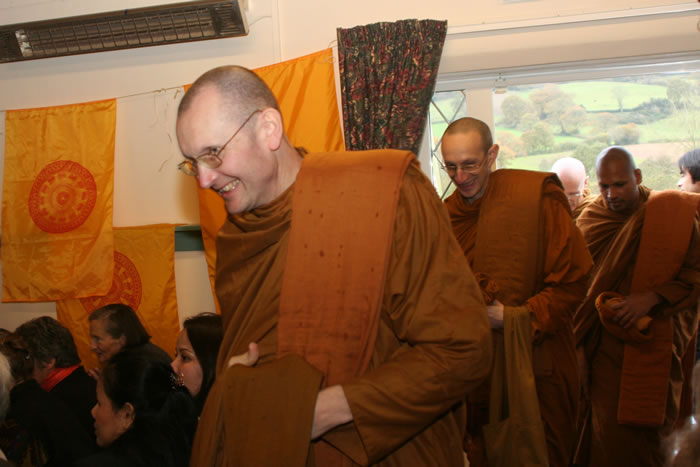
Finally the bhikkhus - the monks, come in and chant a blessing in Pali, the language of the oldest Buddhist writings, the suttas.

Three Bhikkus were offered a meal by an elderly lay supporter who has been a Buddhist for over fifty years. She was celebrating her 80th birthday at her home outside Wincanton.
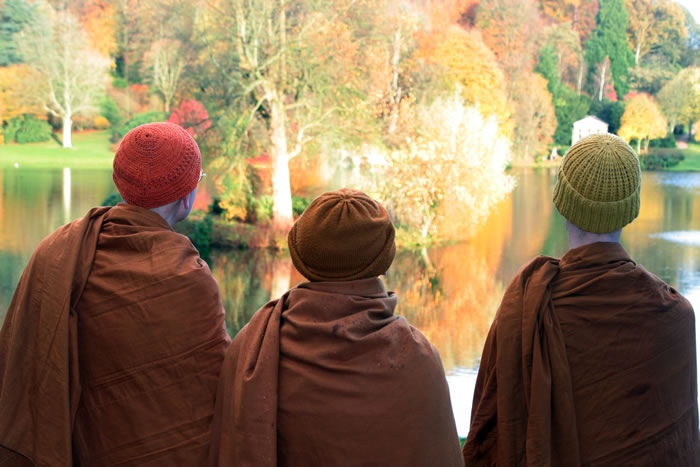
After the meal we took the bhikkus on a walk around the lake at Stourhead. It was a moment of transendance.
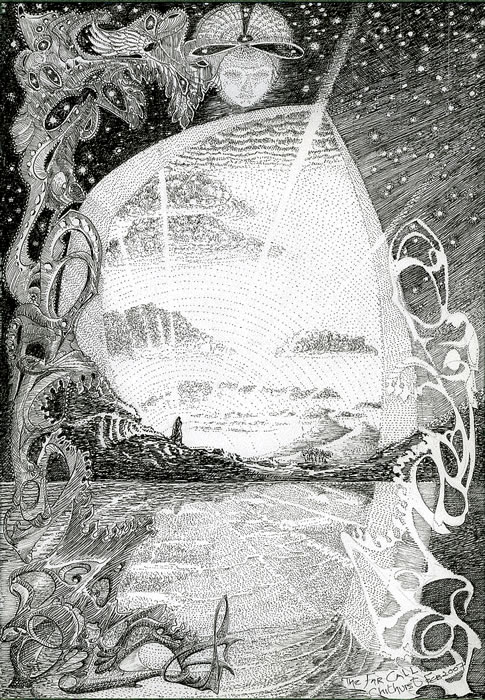
Jane is much appreciated and respected and the bhikkus brought for her this birthday card drawn for her by one of them at the monastery at Chithurst.
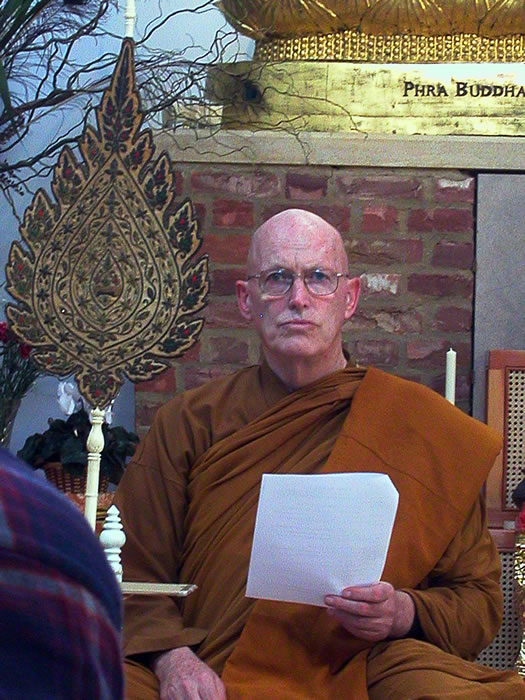
Ajahn Sumedho - looking rather severe here - has lead the community of monks and nuns in this country since coming here in 1977 from Thailand. There he followed the Forest Monastery traditon of Ajahn Chah, a mch revered reformist monk. Originally Robert Jackman he became a bhikkhu in 1967 and was sent here by Ajahn Chah after English Buddhists asked for someone to be sent to introduce the monastic order for Westerners here in Britain. This was a daunting task and had never happened before. The result howeverult has been steady growth. Now in his seventies (b.1934)he has retired from leadership and has retired to live in a monastery in Thailand.

Amaravati Buddhist Monastery at Great Gaddesden outside Hemel Hempstead is the headquarters of the Order with accomodation for monks, nuns, lay guests and workers and for a large retreat centre and this splendid and beautiful temple.
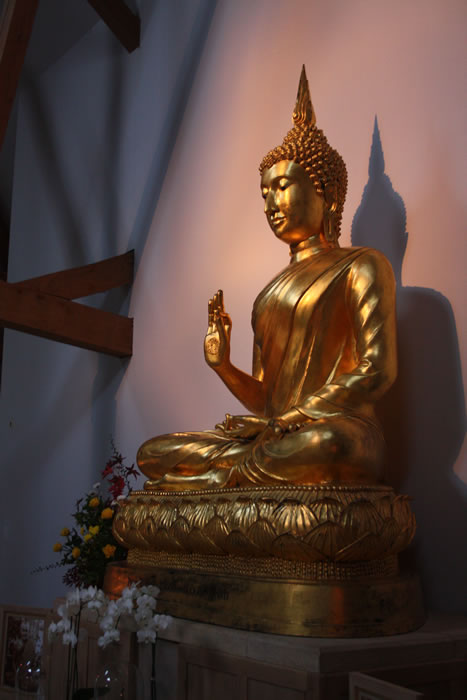
The statue, another gift from Thailand, shows the Buddha proclaiming his teachings. The Buddha is not worshipped as a god but remembered as an awakened and inspiring teacher.

Ajahn Candasiri surrounded by a group of sixty who have just completed a week-long silent retreat under her guidance. Amaravati runs a full programme of retreats which are very well supported and appreciated by lay Buddhists. Places need to be booked well in advance to avoid disappoitment.

This stupa is the focus of a large field used for solitary walking meditation. It is shown hear in the early morning of the retreat I attended lead by Ajahn Candisiri.
www.johnbaxter.org/way-of-the-buddha
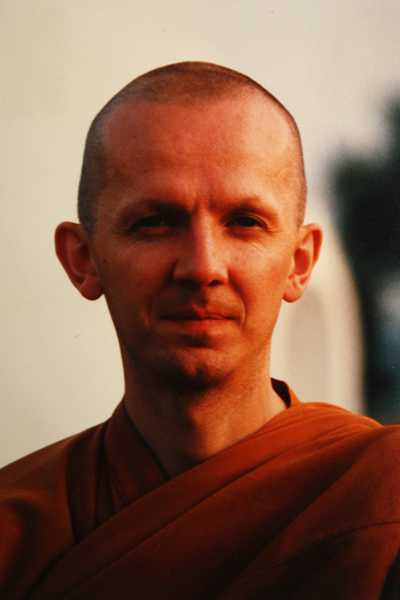
Alan was the first Buddhist I spoke to when by chance we met at the dedication of the Peace Pagoda in Battersea Park in 1985. At that time he was a novice or anagarika. In 1986 he undertook to train as a bhikkhu and continued in the monastic Sangha for 17 years
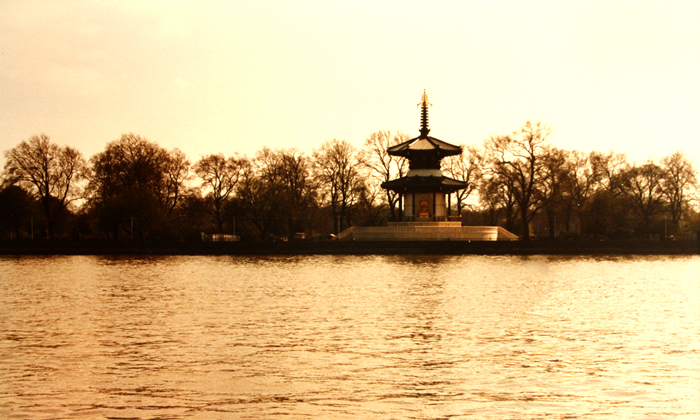
It was here at the Peace Pagoda in Battersea Park that I met the two novices. They were the only two Western Theravada monastics in London that day, and just the people I had come to the city hoping, but not expecting to meet. It was a life changing experience.
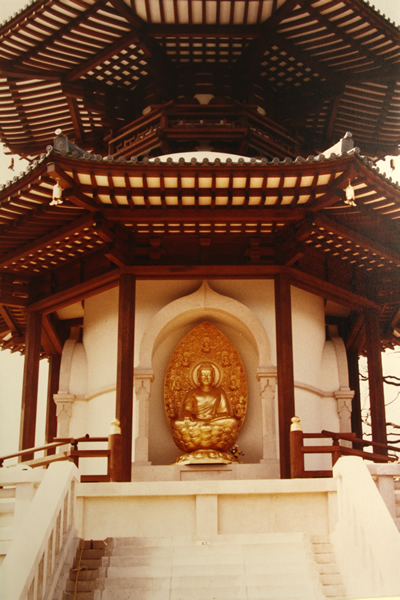
The Peace Pagoda was built by Japanese Buddhist monks followers of the Mahayana monk Nicheren as a gift to the people of London and a reminder of the horrors of nuclear war in the hope that it would never happen again.
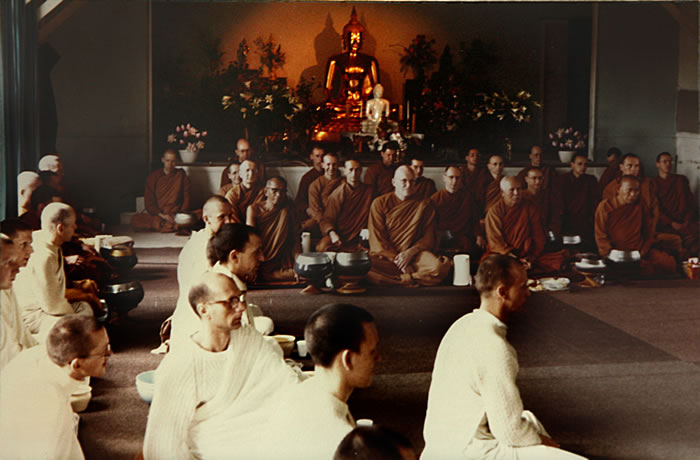
The Opening Ceremony at Amaravati Buddhist Monastery, Great Gaddesden, Herts. in 1985. To support the setting up of this large Western Theravada Monastery, senior monks from both Thailand and Sri Lanka attended as well as a large number of lay people. It was a key moment in the establishing of the Sangha in Britain.
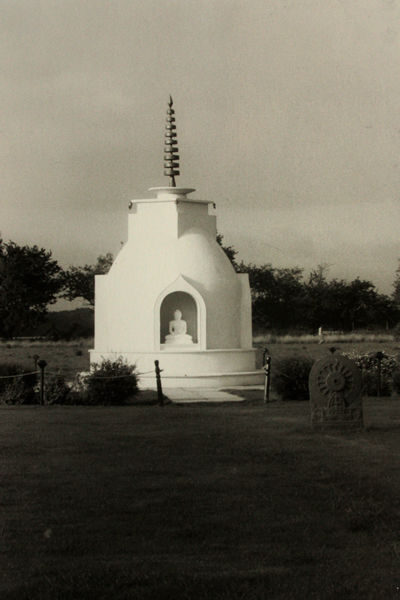
Before the ceremony Bhikkhus and lay people worked to construct this simple pagoda out of mdf and bits and pieces. The high point of the celebration was a procession going around the pagoda three times to take refuge in the Buddha, the Dhamma and the Sangha, Awakening, Truth and Community. It has been replaced by a fine permanent stone stupa containing relics of Ajahn Chah.
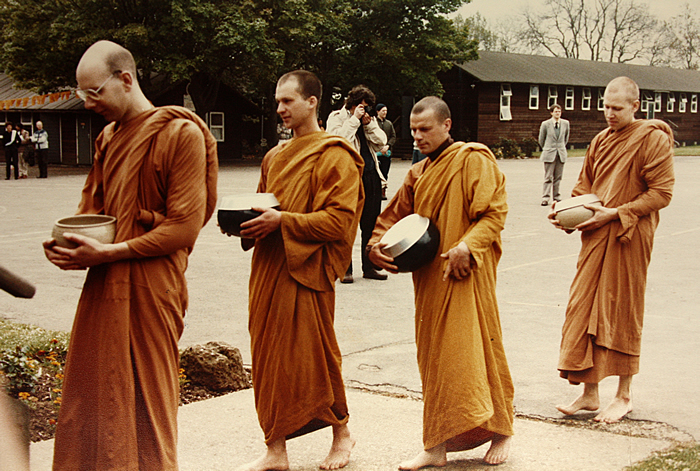
Bhikkhus line up to receive Dana, almsfood from the lay supporters. Forbidden to be self-supporting, the giving and receiving of almsfood is the vital link between the monastic and the lay community.
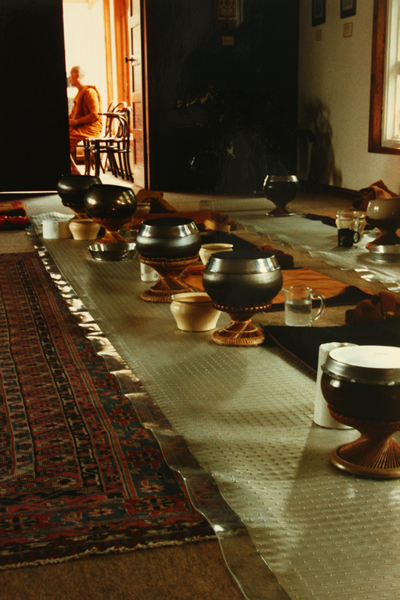
The beautifully made metal almsbowls with their basket and webbing follow a design established at the time of the Buddha.
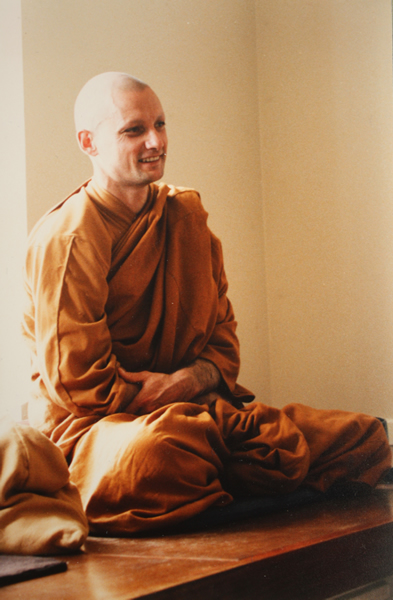
As with the bowl, the robe of a bhikkhu is made to a precise pattern unchanged since the time of the Buddha
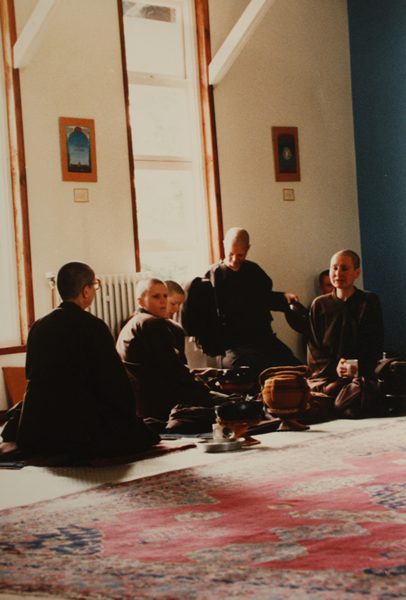
Siladhara. The nuns with their distinguishing brown robes live by an equally demanding and very similar system of training as that followed by the bhikkhus. The Order of siladhara was started when Ajahn Sumedho set up a monastery at Chithurst and a determined group of women insisted they wished to train as renunciates.
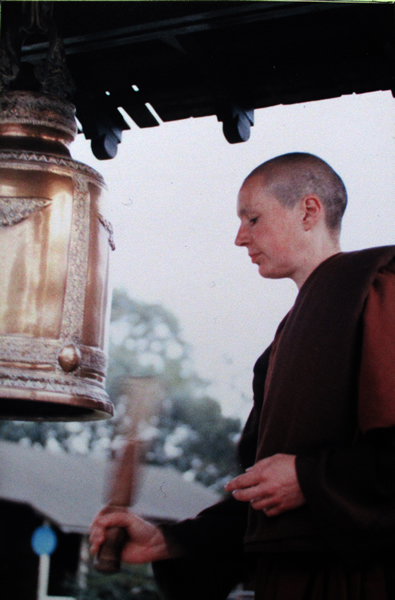
Sister Candasiri, now Ajahn Candasiri rings the monastery bell at Amaravati 1987. Ajahn or Teacher is the title given to monks or nuns who have trained for five years or more and are regarded as ready to teach lay people.
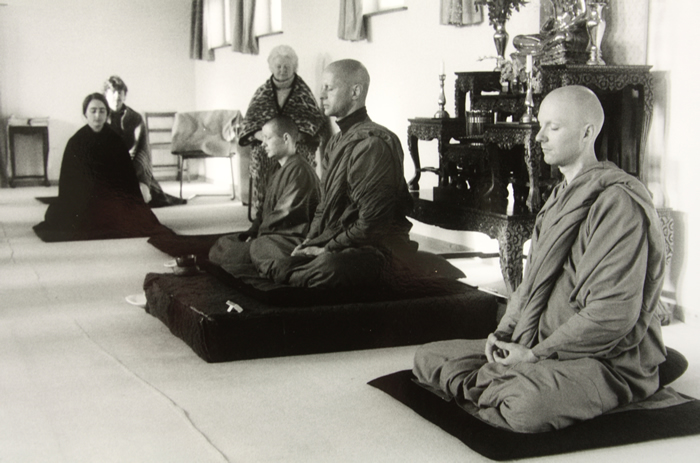
Ajahn Anando, for some years the senior bhikkhu at Chithurst, conducting a retreat in the Retreat Centre at Amaravati where ever since 1985 a very well supported programme of retreats has been taking place.
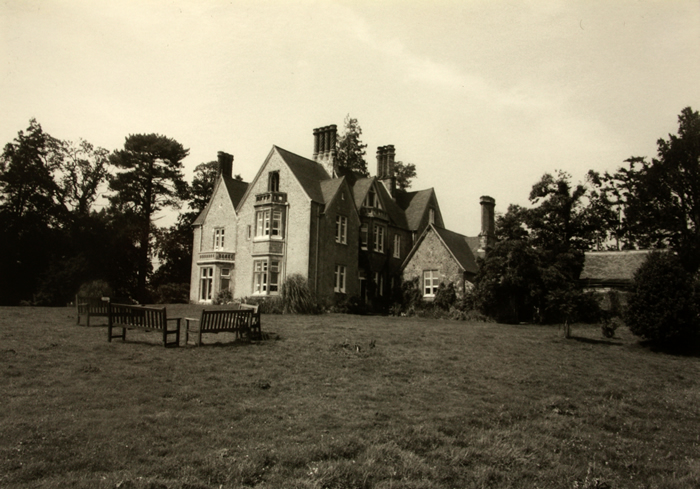
Chithurst or Cittaviveka was established in 1979 by Ajahn Chah and Ajahn Sumedho, who was the first abbot. The current abbot is Ajahn Sucitto who was born in London and became a bhikkhu in 1976. The resident community comprises some 20-25 monks, nuns and novices, as well as lay guests. This picture shows the run down Victorian house as aquired by the English Sangha Trust for the setting up of a monastery. In the last twenty years the house and grounds have been transformed and a splendid sala or meeting hall added.
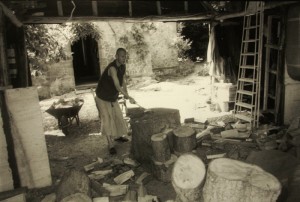
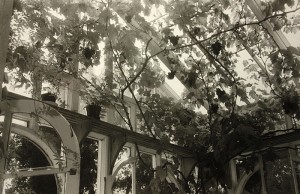 A bhikkhu chopping wood and the vine at Chithurst.
A bhikkhu chopping wood and the vine at Chithurst.
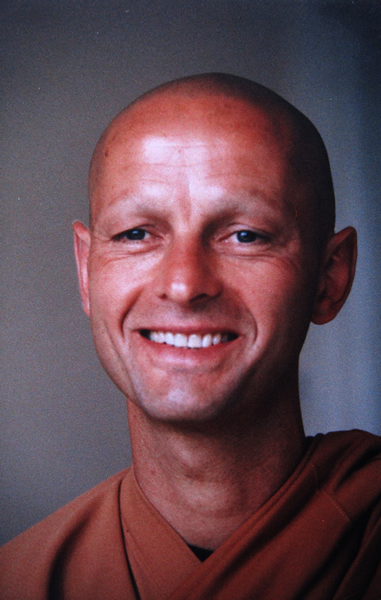
Ajanh Anando, first Abbot of Chithurst. Like several of the first bhikkus, an American Vietnam veteran.
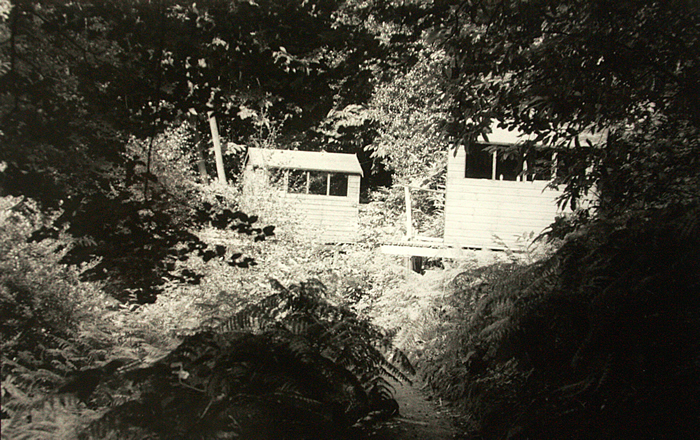
The individual huts or kutis where monks and nuns can stay in the wood for periods of personal retreat.
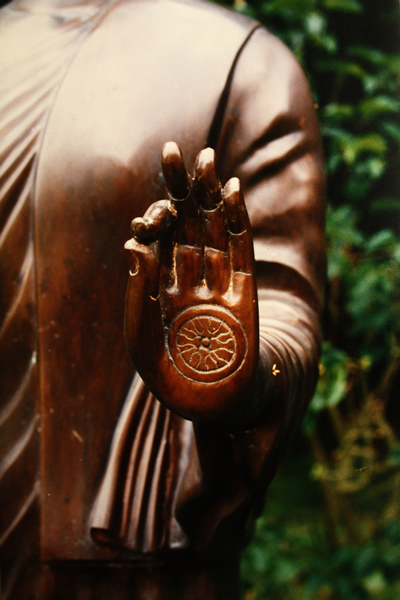
In the garden at Chithurst this fine statue of the Buddha (Buddha Rupa) shows his hand extended in blessing and marked with the wheel of the Noble Eightfold Path of the Middle Way.
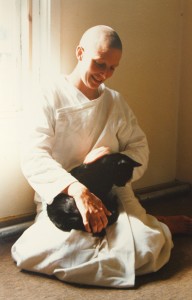
Buddhist monks and nuns do not take vows, but commit themselves to undergo a sytem of training at different levels. The white robe worn here denotes living as an anagarika. Undertaken for one or two years this stage is seen as a novitiate and prepares the candidate either to go on to undertake the full siladhara or a bhikkhu training, or return to lay or householder life.
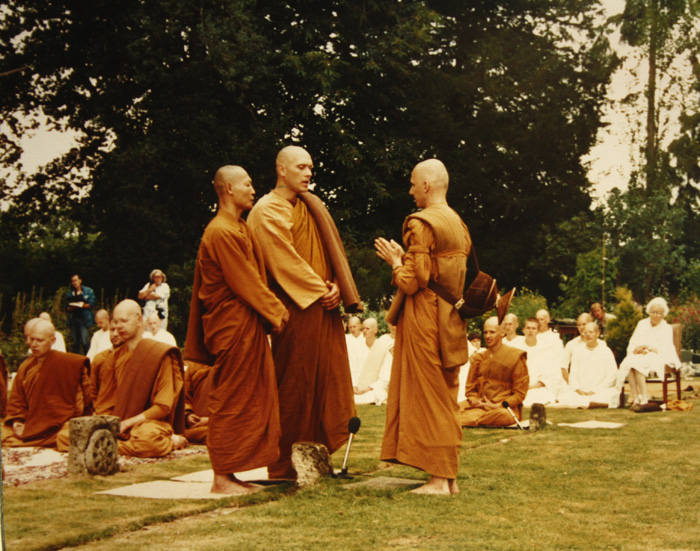
Going Forth from home to homelessness. The ceremony of accepting a novice into the monastic Sangha as a bhikkhu at Chithurst in 1986
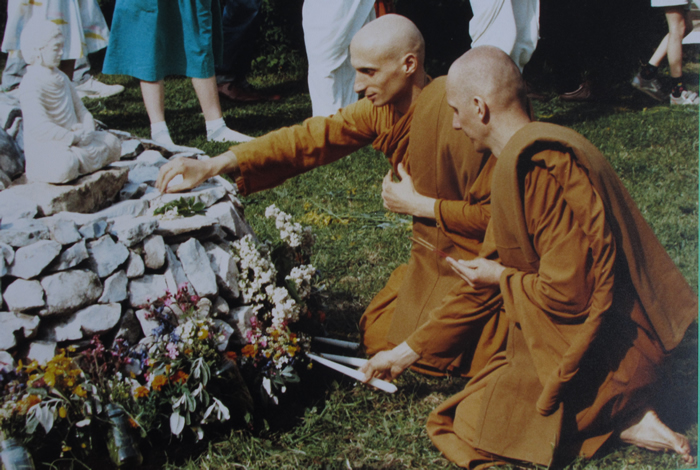
The Opening Ceremony at the Devon Vihara in1986. This, the smallest branch monastery has flourished ever since. Seen here are Ajahn Kittisaro the first monk in charge and Tan Vipassi.
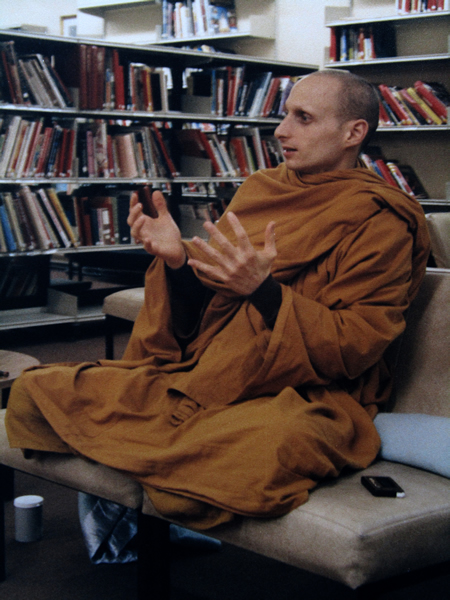
Ajahn Kittisaro as senior monk at the Devon Vihara spent a day teaching an introduction to meditation at Ilfracombe College in 1987. Kittisaro remained a bhikkhu for 15 years. He married a former siladhara of 12 years, Tanissara, and they have been leading retreats and teaching ever since in the US, SA, Israel and the UK.
Wesak. Amaravati 22nd May 2011. The festival of Wesak celebrates the birth, awakening or enlightenment and death of the Buddha and several hundred Thai and Sri Lankan Buddhists, together with a lesser number of Western Buddhists come to the monastery for an inspiring day of reflection, celebration, giving of gifts and financial support to the Sangha, and the enjoyment of an excellent meal – a rare combination of Thai and Sri Lankan dishes. Traditional Buddhists really love these festivals. Some Western Buddhists whose appoach is more cerebral, may miss out on recognising how valuable these joyful occasions are as an expression of the brotherhood of the world wide Buddhist community, for Buddhism was the first world religion transcending race, culture, class, gender and cast in its teaching and practice – at least as the Buddhe intended.
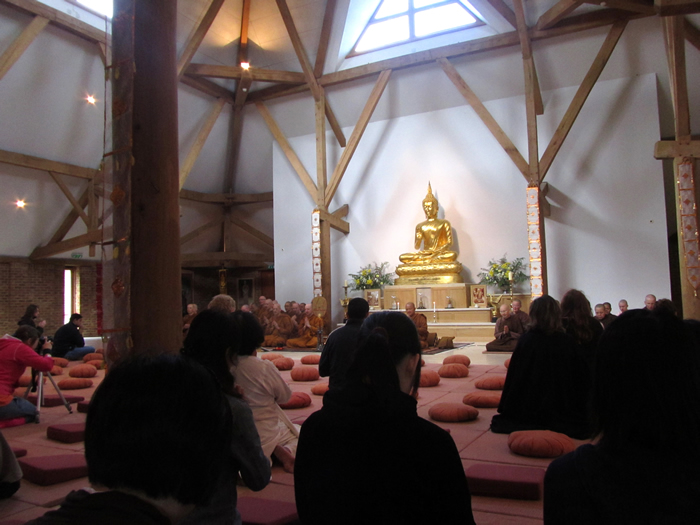
Lay Buddhists unite in following the beautiful chanting by the Sangha in Pali in honour of theBuddha.
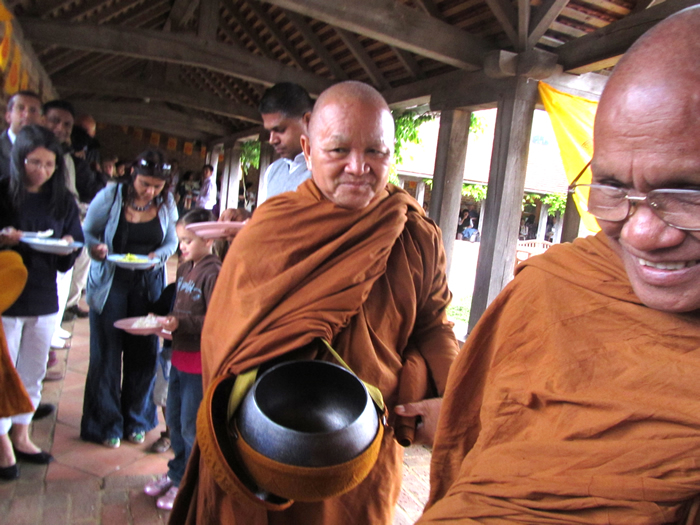
The monastics then come past in order of seniority - that is years in the Order. First the Bhikkhus, then the Siladhara and finally the novices. Japanese Mahayana monks also attended. Each receives a pinch of rice so everyone is able to make a symbolic offering of food to the monastics. It is this act which makes the monastic life possible in the Theravad tradtion and creates the simbiotic community as the Buddha set it up, a community based on generosity, moral living and meditation. This organisation has an unbroken traditon stretching back to the Buddha, Sihatta Gautama, himself.
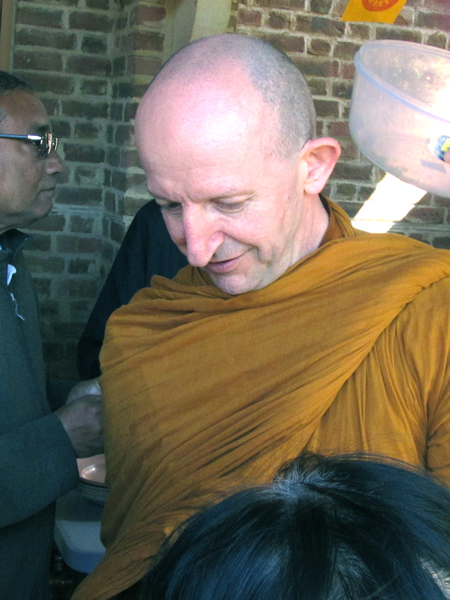
Ajahn Amaro receives rice before leading the monastics into the hall where a great feast is laid out and offered. The monastics then retire to their own quarters to eat.
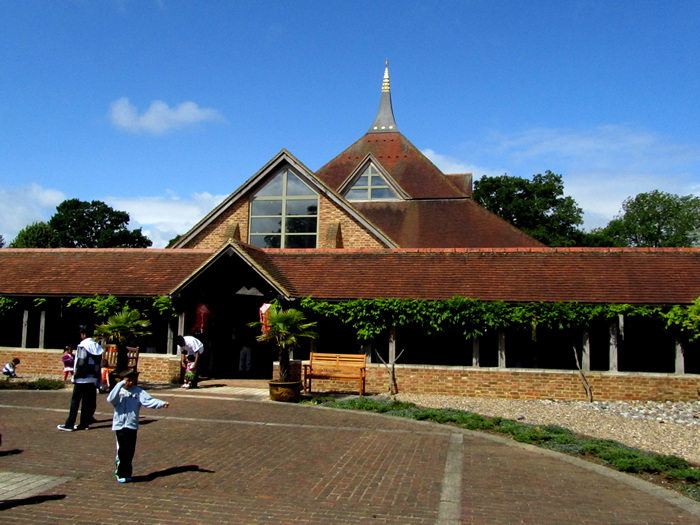
All this takes a bit of time and children run around and play until all the lay people go into the hall.
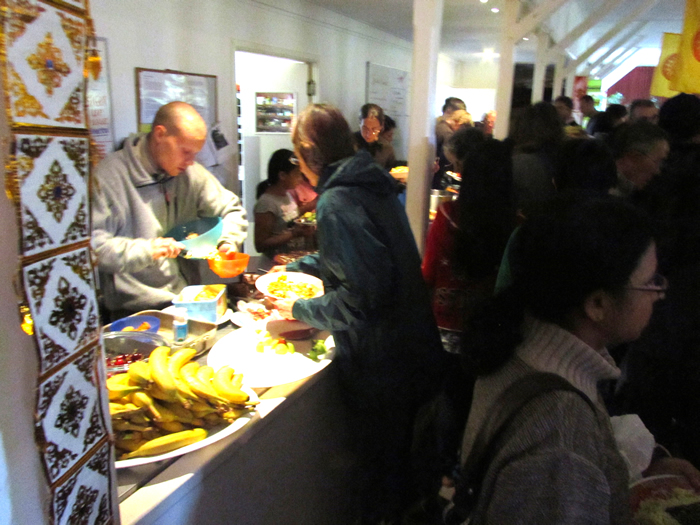
Inside the hall being served to everyone is an amazing cornucopia of food. More than enough for everyone to take their fill. While mostly vegetarian, the Thais also bring chicken dishes for the Buddha, while encouraging respect for animal life, did not , according to Theravada tradition, insist on vegetarianism, instead emphasising the generosity of the giver as being most important for the monastic to recognise.
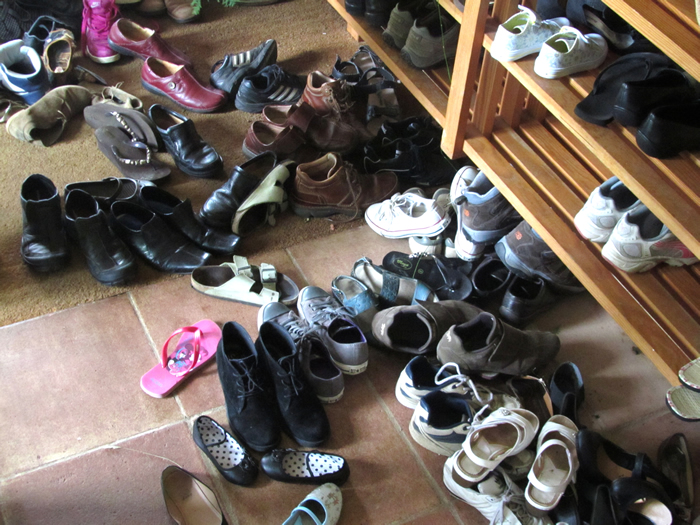
Outside the Temple and outside the hall - the sala - shoes are removed. So much quieter, cleaner and easier for everyone to sit on the floor. An eastern custom, but not a religious necessity, which works very well.
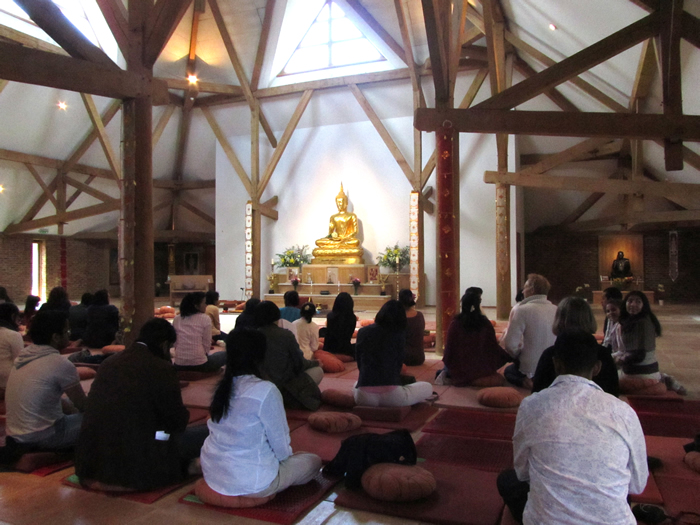
After everyone had eaten their fill people went back into the temple either to sit quietly or to have a chance to talk to Ajahn Amaro and other senior members of the Sangha until the temple was filled to hear the main address given by a senior monkwho had come over from Thailand from the monastery founded by Ajahn Chah. His address, in Thai was then translated into English. Quite challenging, but again an expression of the international nature of the gathering and the crosscultural nature of this the first world religion. This then ended the day.
What follows are pictures of Chithurst Forest Monastery or Cittaviveka (the heart without attachment) taken one evening in July 2011. For details about the monastery there is excellent coverage in Wikipedia. Visiting for the first time in over twenty years I found beautiful new buildings and an atmosphere of inspiring peace and calm. 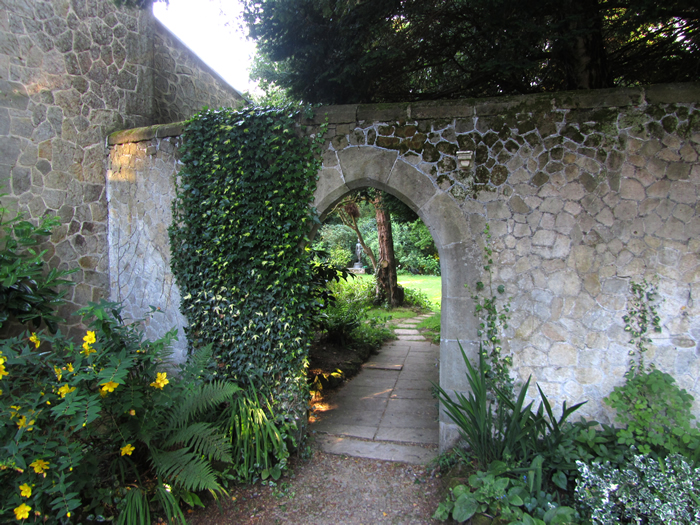 On arrival by the front door is this archway leading to the front garden.
On arrival by the front door is this archway leading to the front garden. 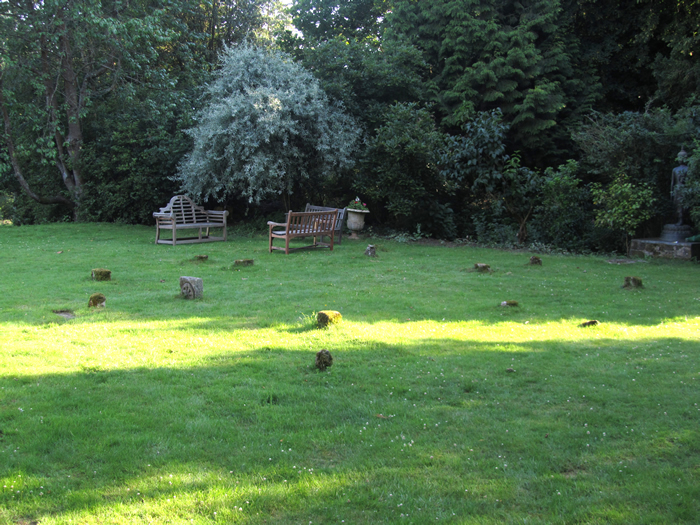 This is the sima or ordination ground featured in the earlier photo of an ordination. It is the first one set out in the prescribed way as laid down by Sangha rules as a place suitable for the ceremony of “going forth” from home to homelessness. These rules safeguard a direct line of succession of monastic teaching, training and discipline stretching back unbroken to the Buddha himself “for the good of the many and for the awakening of the world.”
This is the sima or ordination ground featured in the earlier photo of an ordination. It is the first one set out in the prescribed way as laid down by Sangha rules as a place suitable for the ceremony of “going forth” from home to homelessness. These rules safeguard a direct line of succession of monastic teaching, training and discipline stretching back unbroken to the Buddha himself “for the good of the many and for the awakening of the world.” 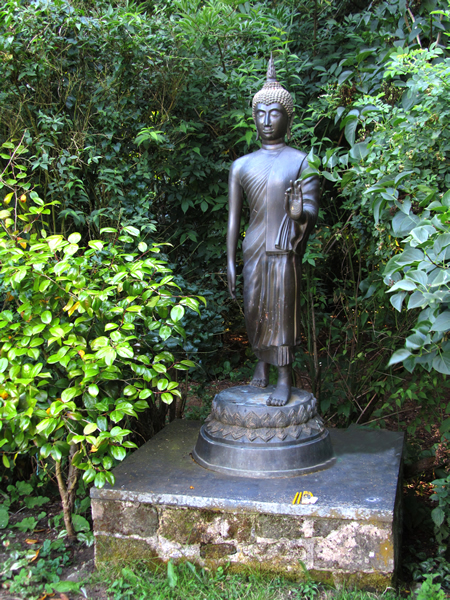 The garden statue of the Buddha. Clearly a gift from Thailand.
The garden statue of the Buddha. Clearly a gift from Thailand. 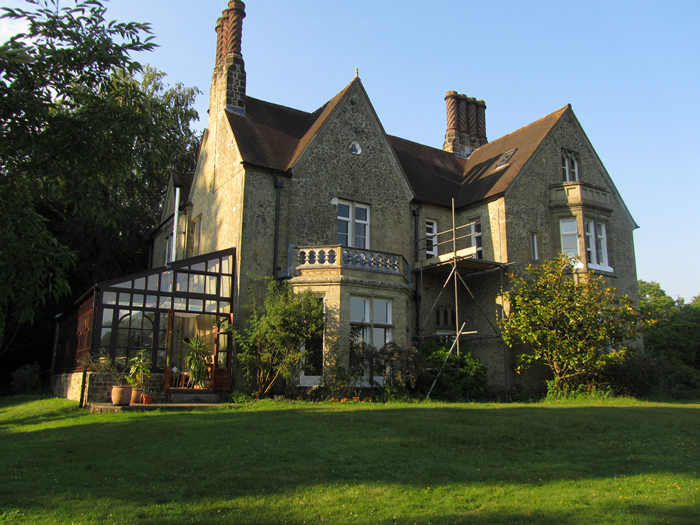 Walking on to the front lawn and looking back at the main house. The shrine-room, the sun room, hall, kitchen , offices and meeting room for tea are on the ground floor. The bhikkus live upstairs.
Walking on to the front lawn and looking back at the main house. The shrine-room, the sun room, hall, kitchen , offices and meeting room for tea are on the ground floor. The bhikkus live upstairs. 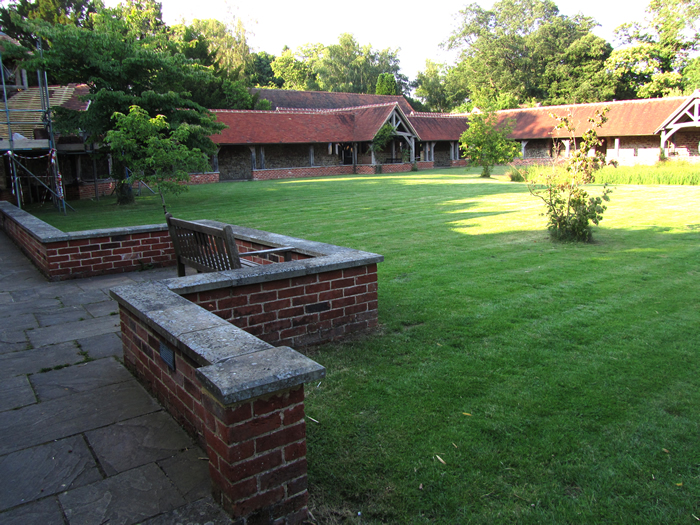 Approaching the Cloister.
Approaching the Cloister. 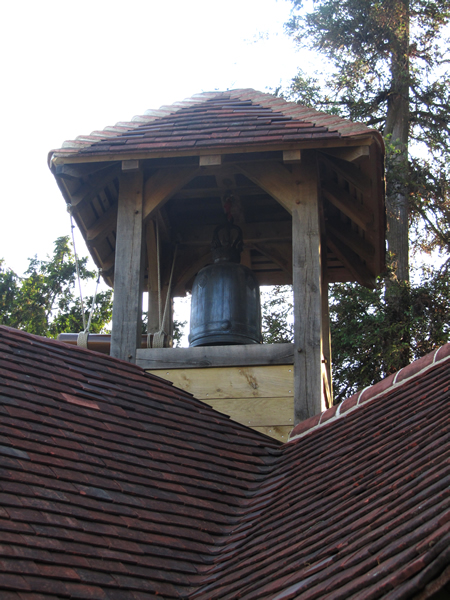 The bell-tower.
The bell-tower. 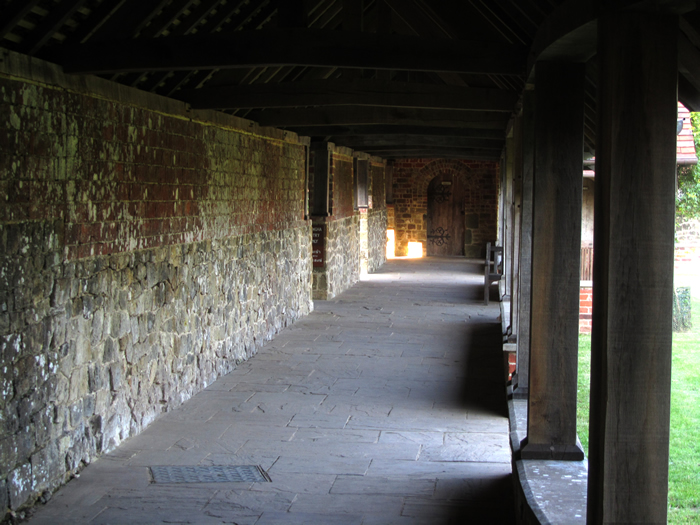 The walls, a mix of weathered bricks and stone.
The walls, a mix of weathered bricks and stone. 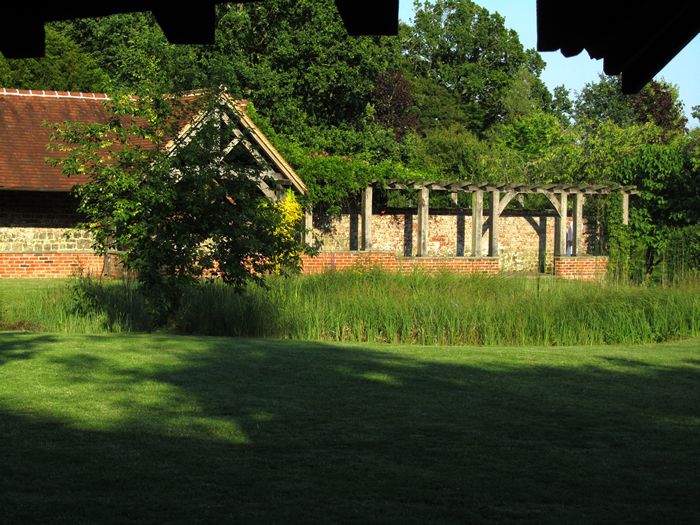 The cloister ends with a terrace and there is a pond surrounded by reads.
The cloister ends with a terrace and there is a pond surrounded by reads. 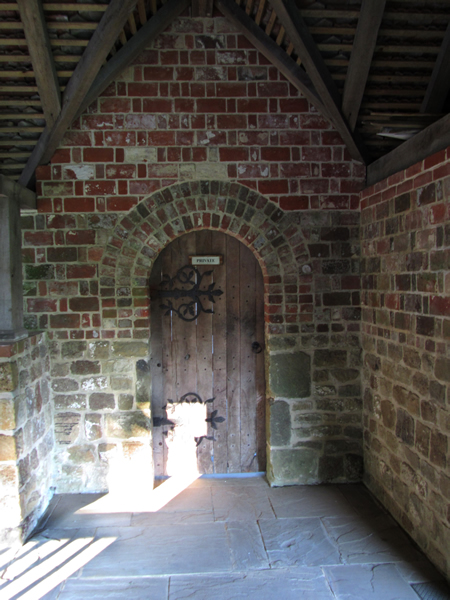 Brick, stone and a cloister door.
Brick, stone and a cloister door. 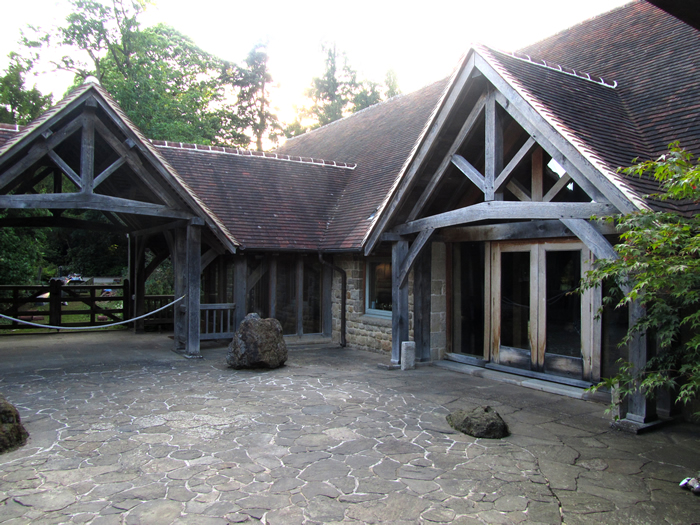 The cloister yard with its beams of weathered wood.
The cloister yard with its beams of weathered wood. 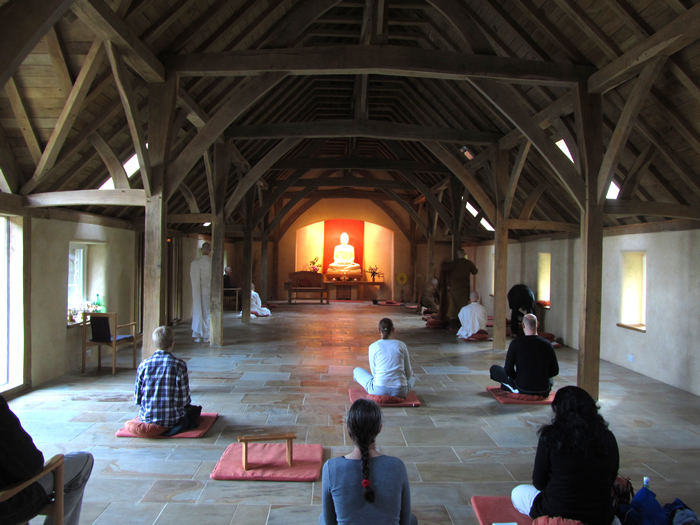 The interior of the Dhamma Hall where every day at 7.30 pm lay supporters and the Sangha congregate for the Evening Chanting, meditation and a dhamma talk.
The interior of the Dhamma Hall where every day at 7.30 pm lay supporters and the Sangha congregate for the Evening Chanting, meditation and a dhamma talk. 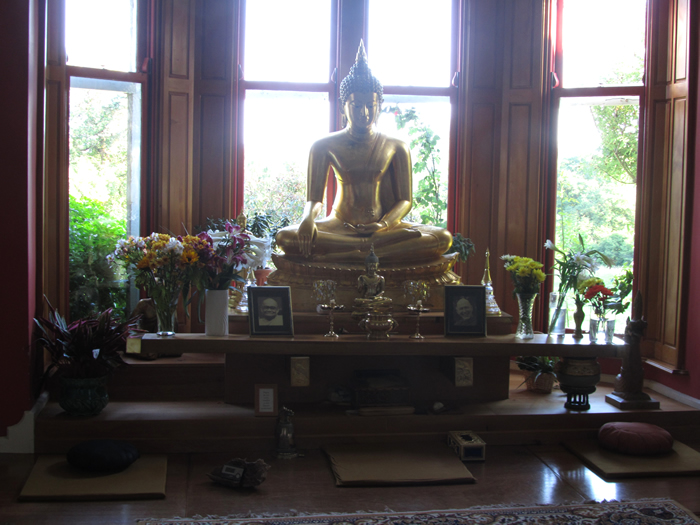 Back inside the house the Shrine Room is little changed
Back inside the house the Shrine Room is little changed 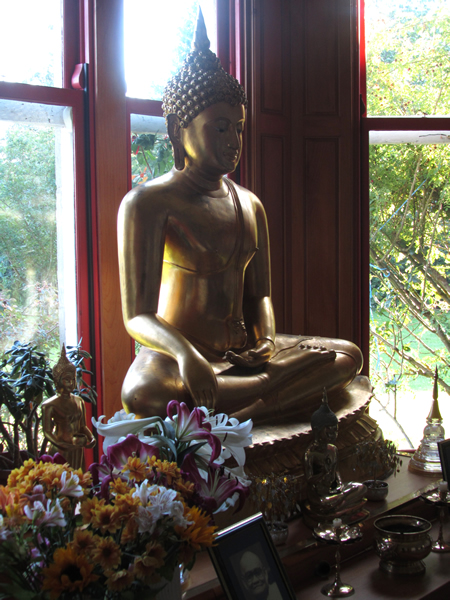 This powerful image of the Buddha depicts him at the moment of Awakening when he touches the ground and knows the way things are.
This powerful image of the Buddha depicts him at the moment of Awakening when he touches the ground and knows the way things are. 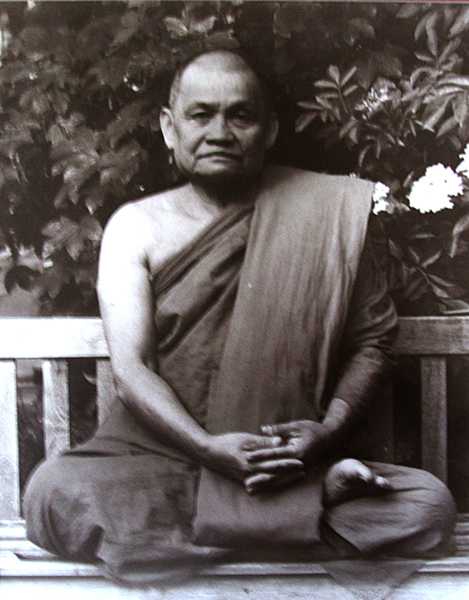 On the walls of the Shrine Room a photograph of Ajahn Chah, founder of the monastery with Ajahn Sumedho.
On the walls of the Shrine Room a photograph of Ajahn Chah, founder of the monastery with Ajahn Sumedho. 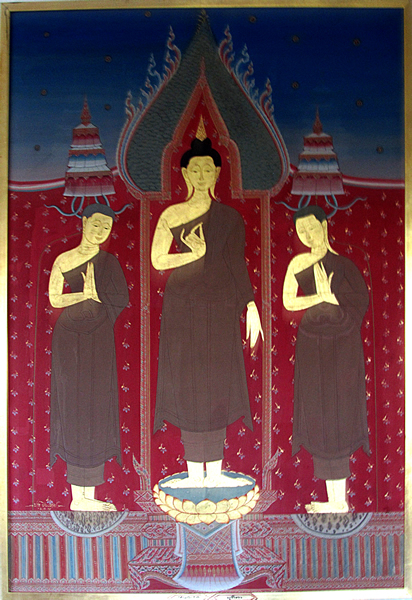 A painting in traditional Thai style showing the Buddha with two disciples.
A painting in traditional Thai style showing the Buddha with two disciples. 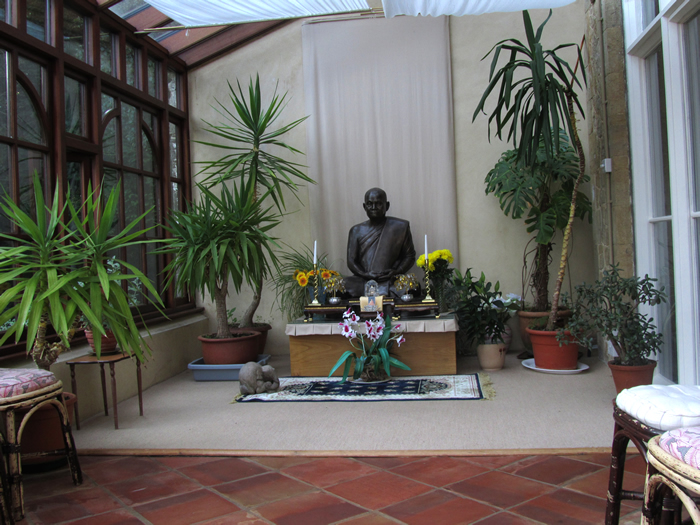 The sun-room leading off the Shrine Room containing an image of Ajahn Chah. The monastery is not a retreat centre, but basically a place for monastic training for bhikkhus and siladhara, and also a place where lay supporters are able to come to stay to take part in and experience living a disciplined contemplative life and working as part of the community. New Shots from Devon. August 2011
The sun-room leading off the Shrine Room containing an image of Ajahn Chah. The monastery is not a retreat centre, but basically a place for monastic training for bhikkhus and siladhara, and also a place where lay supporters are able to come to stay to take part in and experience living a disciplined contemplative life and working as part of the community. New Shots from Devon. August 2011 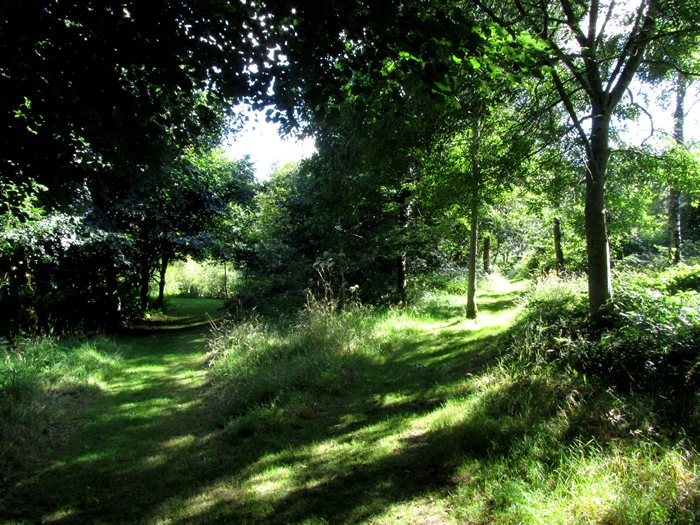 The Devon Vihara is set in the midst of several acres of land which is carefully maintained by the monastics and teams of lay supporters as a nature reserve, following the Buddha’s direction that the best place for contemplation is under a tree and that all living things should be safe on monastic lands.
The Devon Vihara is set in the midst of several acres of land which is carefully maintained by the monastics and teams of lay supporters as a nature reserve, following the Buddha’s direction that the best place for contemplation is under a tree and that all living things should be safe on monastic lands.
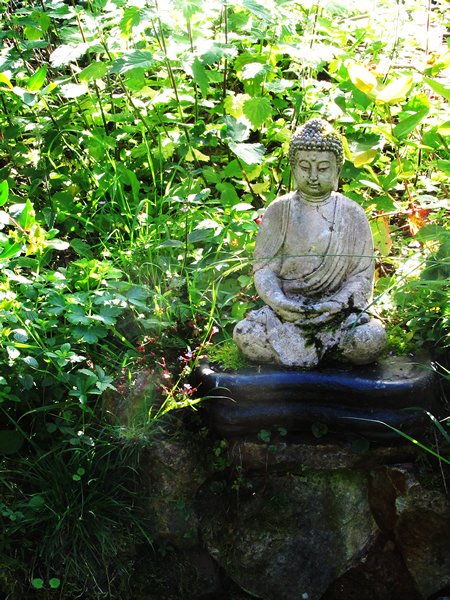 A small Buddha Rupa in the garden. A symbol of awakening/awareness.
A small Buddha Rupa in the garden. A symbol of awakening/awareness.
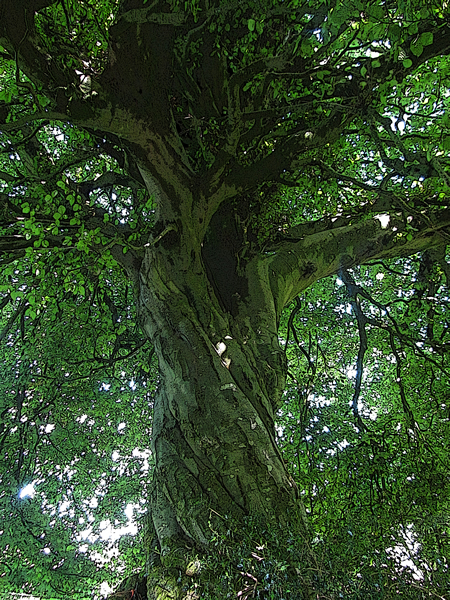 A knarled and twisted tree. Reminder of the Bhodi Tree under which Sidhattha Gautama sat and became truly awake and enlightened.
A knarled and twisted tree. Reminder of the Bhodi Tree under which Sidhattha Gautama sat and became truly awake and enlightened.
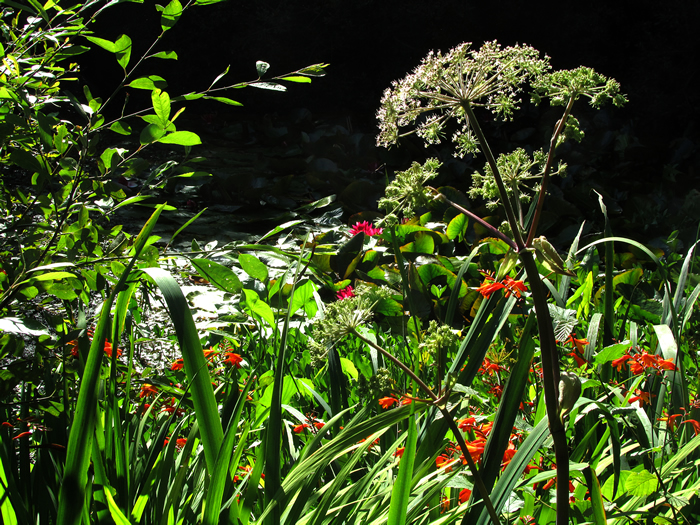 In the midst of the garden a pool surrounded by reeeds and flowers growing wild.
In the midst of the garden a pool surrounded by reeeds and flowers growing wild.
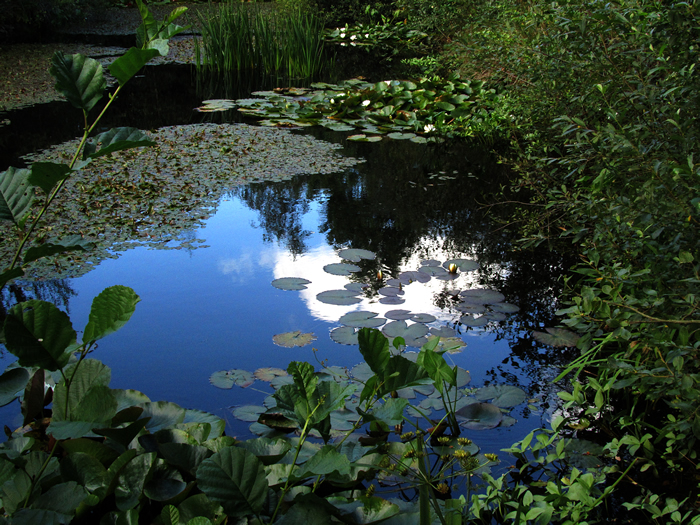 The clear waters reflect the sky and the infinity of space.
The clear waters reflect the sky and the infinity of space.
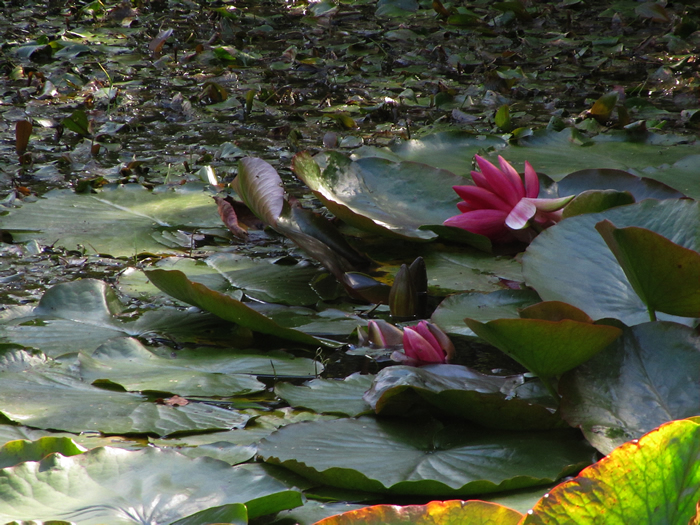 Another symbol of Enlightenment and Awakening. The lotus. growing from the mud at the bottom of the pond it responds to the light and bursts out to flower.
Another symbol of Enlightenment and Awakening. The lotus. growing from the mud at the bottom of the pond it responds to the light and bursts out to flower.
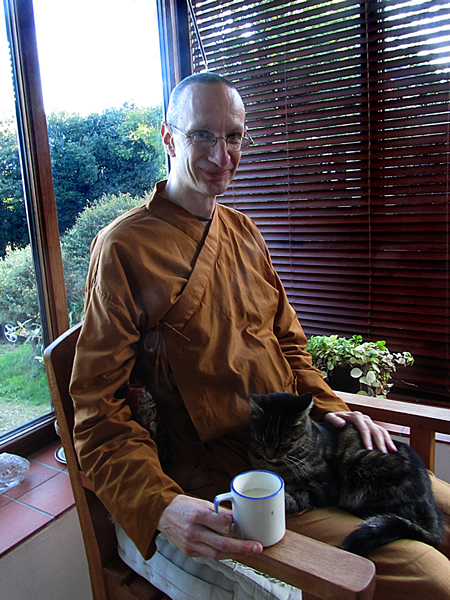 Ajahn Jutindharo, Senior Monk at the Devon Vihara for several years, seen here with the monastery cat. Under his quiet leadership the monastery has steadily flourished offering monastics from the larger monasteries and local and visiting lay people a wonderful place for quiet contemplation and practice of the Buddha Way.
Ajahn Jutindharo, Senior Monk at the Devon Vihara for several years, seen here with the monastery cat. Under his quiet leadership the monastery has steadily flourished offering monastics from the larger monasteries and local and visiting lay people a wonderful place for quiet contemplation and practice of the Buddha Way.




